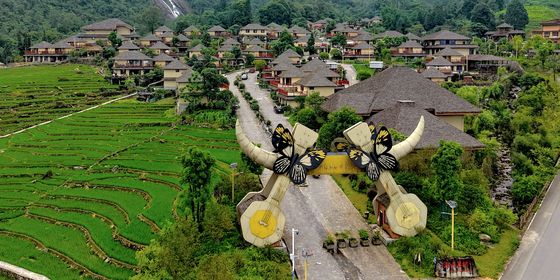The Xixi National Wetland Park contains wonders you might not expect
When one thinks of wetlands what typically comes to mind are tracts of forest and marshes untouched by humans reaching out to the horizon. That’s not what you’ll find at the Xixi National Wetland Park. First of all, these are wetlands that have been painstakingly protected to reflect history—a fitting tribute to Hangzhou’s “man and nature” dance that has been going on for millennia. Second, the Xixi wetlands are just a short cab ride from downtown, so any alligators you were hoping to find have long since gotten jobs in the city. But, all this ignores the purpose of the wetlands: to preserve, protect, and guide the ancient natural beauty of Hangzhou. Today, just five kilometers from the bustling West Lake, nature lovers can traipse over 11 square kilometers of wetlands that have been cultivated by time and manicured by civilization.
History of Xixi
It might seem somewhat strange to consider the history of a natural wetland, but so deep is the history of this area that you cannot talk about it without talking about the ancient, primitive people that shaped the area. Four to five thousand years ago, the Liangzhu people navigated what was then just a large lake in the spring and summer, enjoying the bounty that floated in from the rivers of Tianmu Mountain. When the waters retreated, they were left with the wetlands.

The history of the wetlands truly began with the construction of the Nanhu Lake for flood storage around 1,800 years ago, but it wasn’t until 988 that the Song began to develop Xixi Town—home to fishermen and silkworm farmers alike. Viewed as a utopia, Xixi almost became the location for the Southern Song’s royal palace. Fleeing from the failing Northern Song capital, Emperor Gaozong settled in the peaceful haven of Hangzhou and was eager to have his war-torn spirits recuperated. The tranquil waters and serene greenery of Xixi appealed to the emperor. But Phoenix Hill provided a more favorable strategic location and was eventually chosen. The emperor then told his officials: “西溪且留下”, which loosely means “Save Xixi.” So Xixi was left in peace, and the quote today defines the conservation efforts of the wetlands.

Boating is a popular activity at the Xixi National Wetland Park
For the true Xixi wetlands experience, there is no better way than booking the Fisherman Experience Tour. Interested visitors are encouraged to book online to experience the wetlands with a seasoned fisherman who, armed with nets and generations of knowledge, will hit the still waters to show you how to fish Xixi-style. For those interested in the fishing culture, head to the Misty Water Fishing Village (烟水渔庄) where ramshackle fishing huts stand in the green waters. Inside are exhibitions of their simple, intriguing lives.
The Literati of the Lakes
It’s difficult to talk about anywhere in Hangzhou without talking about poetry, and in the Xixi wetlands the poets and scholars of antiquity lived in peaceful coexistence with nature, choosing it as a bedrock of inspiration.
Foremost among the attractions of the poetry of the Xixi wetlands is perhaps the Xixi Waterside Villas (西溪水阁), considered even today as a site for great literary minds to meet. Nowadays, the site is mainly used as a sort of library of great works, divided into the Blue Stream Book House (蓝溪书屋) and the Yongshu Book Tower (拥书楼), where tourists can walk in the footsteps of the literary greats of years gone by. The reason for its stellar reputation (and, for that matter, its collections) is because it was agreed among many throughout Xixi’s long history that this was where inspiration was born.
河水渔歌
释大善 (明)
渔人不相问, 隔水辨歌音。
菱叶一声绿, 芦花几调深。
自垂溪上钓, 久冷世间心。
小艇番风去, 苍茫何处寻?
Fishermen’s Songs over the River
By Shi Dashan
Among the fishermen, never a greeting is extended;
Songs over the river are all they need.
In the melodies, time passes as the caltrop leaves turn green and reed catkins grow thick.
Over the creeks I angled, my heart for the worldly matters grew cold.
The wind on a small boat I would rather ride, into misty waves to a place no one can find.
More specifically, one might want to visit the Plum and Bamboo Villa (梅竹山庄), built in the 18th century by literary man Zhang Cibai, where, you probably guessed, the highlight is the plum blossoms and thin, wispy strands of bamboo. Traveling southeast from there, literature lovers will find the famous Xixi Thatched House (西溪草堂), formerly home to Ming Dynasty scholar and poet Feng Mengzhen.

Thick reeds surround Autumn Sown Temple
For the most famous spot for literary inspiration in the wetlands, you’re going to need to take a boat. So secluded is the Autumn Snow Temple (秋雪庵) that it is only accessible by water on a solitary islet in the center of the wetlands surrounded by thick reeds. First built in the Song Dynasty, the temple took its name from the autumn scenery of flying reed catkins. A must-visit spot and inspiration for literati over centuries, the temple houses both Buddhist culture and memorial halls of poets from Zhejiang Province.
Birds and Natural Beauty
The natural beauty that inspired all those poets and scholars can still be found today, manicured, one might say, almost to a fault. The first thing that comes to mind when discussing the nature of the Xixi wetlands is that of the birds. While modernity may have chased out a number of predators that used to inhabit much of the area, the waterfowl and egrets of the area are simply stunning against a backdrop of idyllic scenery and Qing-era architecture.
The Xixi wetlands boast 180 different species of birds and are an ideal spot for catching delightful glimpses of egrets, kestrels, and kingfishers. Birds making their tireless journey from Siberia to Australia and back find solace in the calm waters, much to the enjoyment of birdwatchers all over the world who come to hunt for rare species in this heavenly setting.
And, while birds may be what the park is most famous for (along with a few reptiles), its biodiversity is most visible at the Underwater Ecological Observation Corridor (水下生态观光长廊) where curious passersby can observe some of the underwater creatures found in the wetlands. The water, you might expect, is a bit murky, but the fish, snails, and eels are surprisingly friendly—no doubt encouraged by unofficial feeding. And, if you’re really interested and entering from the southeastern gate, check out the National Wetland Museum of China (中国湿地博物馆). Here you’ll find dioramas of different wetlands throughout China, but you’ll also find an area on the top floor dedicated to the Xixi wetlands and their flora and fauna.
Getting Around Paradise
With 11.5 square kilometers of wetlands under conservation, even the most avid hiker will need to admit that doing the whole of the Xixi wetlands on foot is a fool’s errand. That said, there are a number of areas best seen walking at a slow pace, chief among these are the Green Causeway (绿堤) and the Blessed Causeway (福堤). The Green Causeway will take you by the Underwater Ecological Observation Corridor, but, more importantly, it takes you through the Hangzhou Wetland Botanical Garden (杭州湿地植物园), where fans of manicured topiary and flowers are in for a treat. To hike the Green Causeway, enter via the east gate or Wensan West Road access point and follow the signs.
Going west, the Green Causeway meets the Blessed Causeway, and here you’re going to need to make a choice. Head north to perhaps a more peaceful area, which includes the Jiang Village Leisure Life Block (蒋村集市), to grab a bite to eat; or go straight ahead through Hezhu Street (河渚街) packed with shops and diners. South, however, is probably the best option; turn east at the end of causeway after a peaceful walk through the greenery, and you will find Gao Villa (高庄), former home to Emperor Kangxi’s favored official Gao Shiqi, a delicate garden complex once graced by the emperor himself. Then, head to the Lotus Shoal Bird Observation Area (莲花滩观鸟区) to catch a glimpse of the famous Flying Egrets at Lotus Shoal (莲滩鹭影).

Reflection of Red Persimmon in Water is an iconic site at the Xixi National Wetland Park
While a walk is certainly a welcome way to see the Xixi wetlands, you’re going to want a boat for the whole experience. Once you are on Hezhu Street, the closest dock is Shentankou (深潭口); here’s where the wetlands journey really begins. Until now, while certainly marshy and with landscapes to amaze, your journey will have been relatively landlocked. Board one of the electric boats for a leisurely guided cruise on a circuit around some of the most amazing sites in the wetlands, including the thick reeds covering Autumn Snow Temple (the islet is accessible by sculling boat), Reflection of Red Persimmon in Water (火柿映波), and Plum and Bamboo Villa (best visited in September) where, incidentally, there is a harbor where one might hop on a sculling boat for a more intimate (though pricier) tour of the northern charms of the wetlands. Should you choose to stay on the electric boat, there’s another highlight ahead: Misty Water Fishing Village, an assembly of architecture and culture that brings the past to life. From here, you can give your rested feet a test and head back to the Blessed Causeway.
There is no right way to see the Xixi wetlands. It is an area of unmatched peace and quiet just a few kilometers from the city—teeming with history and hemmed by natural beauty. The only true thing that can be said of the Xixi wetlands is that if you haven’t seen them, you haven’t really seen Hangzhou.
Photographs by Chen Zhenxian (陈振贤) and Mo Xiaoping (莫晓萍)
Excerpt taken from Hangzhou At A Glance by TWOC. You can pick up a copy from our store or grab the digital version on our China Dispatch app. Go get your copy now.













